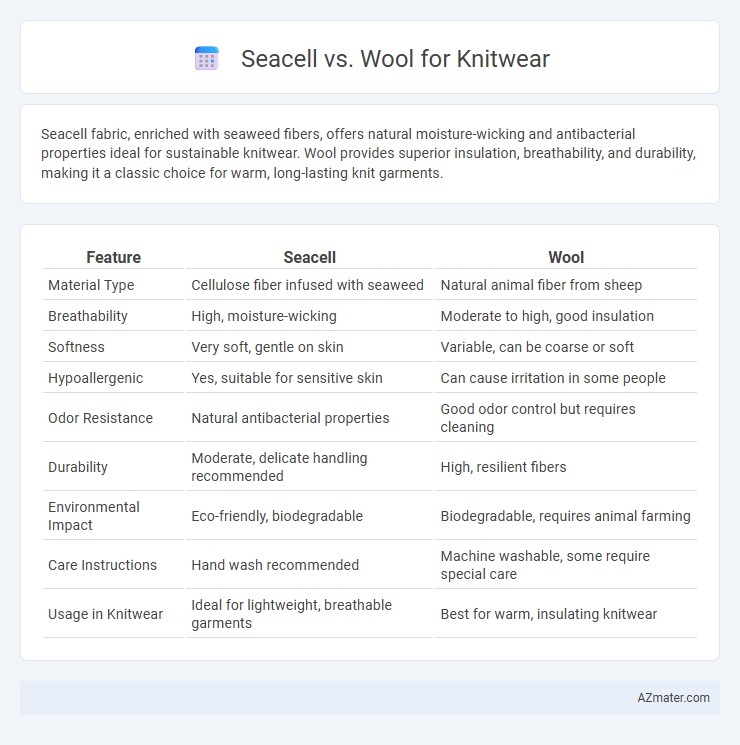Seacell fabric, enriched with seaweed fibers, offers natural moisture-wicking and antibacterial properties ideal for sustainable knitwear. Wool provides superior insulation, breathability, and durability, making it a classic choice for warm, long-lasting knit garments.
Table of Comparison
| Feature | Seacell | Wool |
|---|---|---|
| Material Type | Cellulose fiber infused with seaweed | Natural animal fiber from sheep |
| Breathability | High, moisture-wicking | Moderate to high, good insulation |
| Softness | Very soft, gentle on skin | Variable, can be coarse or soft |
| Hypoallergenic | Yes, suitable for sensitive skin | Can cause irritation in some people |
| Odor Resistance | Natural antibacterial properties | Good odor control but requires cleaning |
| Durability | Moderate, delicate handling recommended | High, resilient fibers |
| Environmental Impact | Eco-friendly, biodegradable | Biodegradable, requires animal farming |
| Care Instructions | Hand wash recommended | Machine washable, some require special care |
| Usage in Knitwear | Ideal for lightweight, breathable garments | Best for warm, insulating knitwear |
Introduction to Seacell and Wool in Knitwear
Seacell, a sustainable fiber derived from seaweed and cellulose, offers natural moisture-wicking and antibacterial properties, making it an innovative choice for eco-friendly knitwear. Wool, traditionally sourced from sheep, is prized for its exceptional insulation, breathability, and durability, commonly used in knitwear for warmth and comfort. Both fibers serve distinct functions in knitwear, with Seacell providing a soft, skin-friendly texture and Wool delivering superior thermal regulation.
Origins and Production Methods
Seacell fabric is derived from seaweed fibers combined with cellulose, using an eco-friendly wet spinning process that retains the seaweed's natural nutrients beneficial for skin. Wool originates from sheep fleece and undergoes mechanical shearing, cleaning, and spinning, emphasizing sustainable animal husbandry practices for high-quality yarn. The production of Seacell emphasizes bioactive properties and sustainability, while wool production focuses on renewable natural fiber with thermal insulation qualities.
Sustainability and Environmental Impact
Seacell, derived from renewable seaweed fibers, offers strong sustainability benefits by being biodegradable and requiring low water and chemical inputs during production, significantly reducing environmental impact compared to traditional wool. Wool, sourced from sheep, is natural and biodegradable but its farming often involves considerable land use, methane emissions, and water consumption, posing challenges in environmental sustainability. Choosing Seacell fiber for knitwear supports eco-friendly manufacturing with renewable resources, while wool's impact varies greatly depending on farming practices and regions.
Fiber Properties and Composition
Seacell fiber combines cellulose from seaweed with lyocell, offering natural antibacterial, moisture-wicking, and skin-soothing properties beneficial for knitwear. Wool, derived from sheep's fleece, provides excellent insulation, elasticity, and moisture retention due to its protein-based structure, making it ideal for warmth and durability. The blend or choice between Seacell and wool impacts knitwear performance, with Seacell enhancing comfort and skin benefits, while wool ensures thermal regulation and resilience.
Comfort and Wearability
Seacell fiber in knitwear offers superior moisture management and breathability, enhancing comfort by keeping the skin dry and cool, which is ideal for sensitive or active wearers. Wool excels in natural thermal regulation and elasticity, providing warmth and durability while maintaining softness that adapts to body temperature changes. Both fibers contribute to wearability, but Seacell's hypoallergenic properties and wool's long-lasting resilience cater to different preferences in knitwear comfort.
Insulation and Breathability
Seacell fabric offers superior breathability compared to wool, thanks to its natural seaweed fibers that enhance moisture management and keep the skin dry. Wool excels in insulation with its crimped fibers trapping air, providing excellent warmth even when damp, making it ideal for cold climates. While Seacell blends promote comfort and temperature regulation, wool remains the preferred choice for maximum insulation in knitwear.
Durability and Longevity
Seacell fiber, derived from seaweed and cellulose, offers moderate durability but may degrade faster with frequent washing compared to wool, which is known for its exceptional resilience and ability to retain shape over time. Wool fibers naturally resist wear and tear, making wool knitwear highly durable and long-lasting even in heavy use. While Seacell provides added moisture absorption and skin benefits, wool's robust structure and elasticity ensure superior longevity in knitwear applications.
Care and Maintenance Requirements
Seacell knitwear requires gentle washing with mild detergent, avoiding bleach and high temperatures to preserve its natural seaweed fibers and prevent color fading. Wool garments need careful hand washing or dry cleaning to maintain their shape and avoid shrinkage, with special attention to drying flat and away from direct heat sources. Both fibers benefit from minimal agitation and storing in breathable containers to prevent damage and retain softness.
Price and Market Availability
Seacell knitwear generally commands a higher price than wool due to its eco-friendly production and skincare benefits, targeting a niche market segment. Wool remains widely available and more affordable, benefiting from extensive sourcing and established supply chains in global markets. Market availability for Seacell is limited primarily to specialty and sustainable fashion brands, whereas wool dominates mainstream knitwear retail channels.
Which Fiber is Best for Your Knitwear?
Seacell fiber, derived from seaweed and blended with soft cellulose, offers exceptional moisture-wicking and antibacterial properties, making it ideal for sensitive skin and activewear knitwear. Wool, known for its natural insulation, breathability, and durability, excels in warmth and odor resistance, suitable for cold-weather garments. Choosing between Seacell and wool depends on the desired knitwear performance: Seacell for softness and skin benefits, if comfort and sustainability are priorities, while wool remains unmatched for thermal regulation and longevity.

Infographic: Seacell vs Wool for Knitwear
 azmater.com
azmater.com